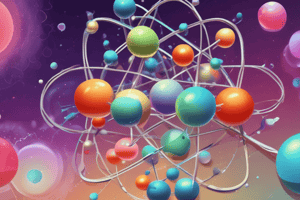Podcast
Questions and Answers
What is the main focus of inorganic chemistry?
What is the main focus of inorganic chemistry?
- The behavior of living organisms
- The behavior of organic compounds
- The behavior of elements in their non-living forms (correct)
- The behavior of elements with carbon-centered covalent bonds
What is the smallest unit of an element that retains the element's chemical properties?
What is the smallest unit of an element that retains the element's chemical properties?
- Compounds
- Molecules
- Atoms (correct)
- Ions
What are ions in chemistry?
What are ions in chemistry?
- Atoms or molecules that have gained or lost electrons (correct)
- Compounds with covalent bonds
- Elements in their natural form
- Particles with negative charge
How do cations and anions differ?
How do cations and anions differ?
What does the periodic table organize elements based on?
What does the periodic table organize elements based on?
When does ionic bonding occur?
When does ionic bonding occur?
What type of bonding involves the sharing of electrons between atoms?
What type of bonding involves the sharing of electrons between atoms?
Which compound is an example of a compound formed through ionic bonding?
Which compound is an example of a compound formed through ionic bonding?
In which type of bonding do metal atoms lose electrons to form a 'sea' of delocalized electrons?
In which type of bonding do metal atoms lose electrons to form a 'sea' of delocalized electrons?
What is the main focus of inorganic chemistry in materials science?
What is the main focus of inorganic chemistry in materials science?
What area does inorganic chemistry contribute to in terms of environmental science?
What area does inorganic chemistry contribute to in terms of environmental science?
Which field benefits from the development of new methods for energy production by inorganic chemistry?
Which field benefits from the development of new methods for energy production by inorganic chemistry?
Flashcards are hidden until you start studying
Study Notes
Exploring Inorganic Chemistry
Inorganic chemistry is the branch of chemistry that focuses on the behavior of elements in their non-living forms, particularly those without carbon-centered covalent bonds. This vast and fascinating realm encompasses the study of everything from the Earth's crust to the stars, including elements like hydrogen, oxygen, and metals.
Atoms and Ions
The foundation of inorganic chemistry lies in the understanding of atoms and ions. Atoms are the smallest unit of an element that retains the element's chemical properties, while ions are atoms or molecules that have either gained or lost electrons, acquiring a positive or negative charge. Ions form when atoms either lose one or more electrons to become positively charged (cations) or gain one or more electrons to become negatively charged (anions).
Periodic Table
The periodic table is a fundamental tool in inorganic chemistry, organizing elements based on their atomic number and electronic configurations. It helps chemists understand trends in the properties of elements and predict the behavior of new elements.
Compounds and Bonding
Inorganic compounds are formed by the combination of elements through various types of bonding, such as ionic, covalent, and metallic. These bonds result in the formation of crystalline solids, liquids, and gases.
Ionic bonding occurs when electrostatic forces of attraction draw positively charged cations to negatively charged anions. This type of bonding is common in the formation of salts and other inorganic compounds, such as sodium chloride (NaCl).
Covalent bonding involves the sharing of electrons between atoms to achieve a stable electron configuration. This type of bonding is present in many inorganic compounds like water (H2O) and hydrogen fluoride (HF).
Metallic bonding occurs when metal atoms lose electrons to form a 'sea' of delocalized electrons, resulting in a strong metallic lattice. This type of bonding is characteristic of metals and their alloys.
Applications of Inorganic Chemistry
Inorganic chemistry has numerous applications in various fields, including:
- Materials science: The development of new materials for electronic devices, solar cells, and batteries.
- Environmental science: The study of chemical processes and pollutants in the environment and the development of methods to mitigate these problems.
- Industrial processes: The production of fertilizers, pigments, and catalysts to improve industrial processes and increase efficiency.
- Energy production: The development of new methods for producing and storing energy, such as solar cells, fuel cells, and batteries.
- Nanotechnology: The study of inorganic materials at the nanoscale and the development of new nanomaterials for various applications.
Inorganic chemistry is a dynamic and ever-evolving field that continues to provide new insights into the behavior of elements and their compounds. The understanding of these concepts and their applications will continue to drive innovation and progress in various fields, from materials science to environmental science, and beyond.
[Note: This article is not intended as a comprehensive guide to inorganic chemistry or its subtopics. Rather, it aims to provide a general overview and an introduction to the field, focusing on the key concepts and their applications.]
Studying That Suits You
Use AI to generate personalized quizzes and flashcards to suit your learning preferences.


